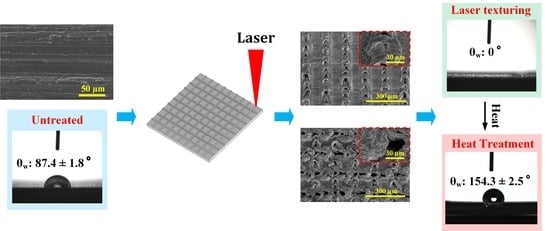Modulation and Control of Wettability and Hardness of Zr-Based Metallic Glass via Facile Laser Surface Texturing
Abstract
:1. Introduction
2. Materials and Methods
2.1. Materials
2.2. Laser-Based Surface Texturing
2.3. Surface Characterizations
3. Results
3.1. Surface Morphology
3.2. Surface Wettability
3.3. Surface Chemistry
3.4. Surface Microhardness
3.5. Processing Mechanism Analysis
4. Conclusions
- (1)
- The developed laser-based surface texturing technique consists of two steps: laser texturing and heat treatment. Laser texturing generated the periodic surface structures and oxidized the BMG surface, while the subsequent heat treatment accelerated the absorption of hydrophobic airborne organic compounds and deposited a thin PDMS layer on the laser textured BMG surface.
- (2)
- It is found that the untreated BMG surface is hydrophilic with a θw of 84.4 ± 1.2°. Immediately upon laser texturing, the laser textured BMG surface exhibited a θw of 0°, indicating the surface turned superhydrophilic. After a heat treatment of 2 h, the laser textured BMG surface became superhydrophobic with a θw higher than 150°.
- (3)
- Through careful experimental validation and analysis, it is believed that the laser-induced surface texture and modified surface chemistry are equally important for achieving the desirable wettability condition.
- (4)
- The microhardness of the laser textured BMG surface is also notably increased due to the higher microstructure density and more grain boundaries generated on account of the laser surface texturing process.
Author Contributions
Funding
Acknowledgments
Conflicts of Interest
References
- Miller, M.; Liaw, P. Bulk Metallic Glasses; Springer: Boston, MA, USA, 2008; ISBN 9780387489209. [Google Scholar]
- Löffler, J.F. Bulk metallic glasses. Intermetallics 2003, 11, 529–540. [Google Scholar] [CrossRef]
- Telford, M. The case for bulk metallic glass. Mater. Today 2004, 7, 36–43. [Google Scholar] [CrossRef]
- Bian, Z.; Chen, G.L.; He, G.; Hui, X.D. Microstructure and ductile-brittle transition of as-cast Zr-based bulk glass alloys under compressive testing. Mater. Sci. Eng. A 2001, A316, 135–144. [Google Scholar] [CrossRef]
- Huang, H.; Yan, J. Investigating shear band interaction in metallic glasses by adjacent nanoindentation. Mater. Sci. Eng. A 2017, A704, 375–385. [Google Scholar] [CrossRef]
- Liu, W.; Zhang, H.; Shi, J.A.; Wang, Z.; Song, C.; Wang, X.; Lu, S.; Zhou, X.; Gu, L.; Louzguine-Luzgin, D.V.; et al. A room-temperature magnetic semiconductor from a ferromagnetic metallic glass. Nat. Commun. 2016, 7, 13497. [Google Scholar] [CrossRef] [PubMed] [Green Version]
- Li, H.F.; Zheng, Y.F. Recent advances in bulk metallic glasses for biomedical applications. Acta Biomater. 2016, 36, 1–20. [Google Scholar] [CrossRef] [PubMed]
- Khan, M.M.; Nemati, A.; Rahman, Z.U.; Shah, U.H.; Asgar, H.; Haider, W. Recent Advancements in Bulk Metallic Glasses and Their Applications: A Review. Crit. Rev. Solid State Mater. Sci. 2018, 43, 233–268. [Google Scholar] [CrossRef]
- Chen, N.; Frank, R.; Asao, N.; Louzguine-Luzgin, D.V.; Sharma, P.; Wang, J.Q.; Xie, G.Q.; Ishikawa, Y.; Hatakeyama, N.; Lin, Y.C.; et al. Formation and properties of Au-based nanograined metallic glasses. Acta Mater. 2011, 59, 6433–6440. [Google Scholar] [CrossRef]
- Ketov, S.V.; Shi, X.; Xie, G.; Kumashiro, R.; Churyumov, A.Y.; Bazlov, A.I.; Chen, N.; Ishikawa, Y.; Asao, N.; Wu, H.; et al. Nanostructured Zr-Pd metallic glass thin film for biochemical applications. Sci. Rep. 2015, 5, 7799. [Google Scholar] [CrossRef] [Green Version]
- Zhao, M.; Abe, K.; Yamaura, S.; Yamamoto, Y.; Asao, N. Fabrication of Pd−Ni−P Metallic Glass Nanoparticles and Their Application as Highly Durable Catalysts in Methanol Electro-oxidation. Chem. Mater. 2014, 26, 1056–1061. [Google Scholar] [CrossRef]
- Kumar, G.; Tang, H.X.; Schroers, J. Nanomoulding with amorphous metals. Nature 2009, 457, 868–872. [Google Scholar] [CrossRef] [PubMed]
- Hu, Z.; Gorumlu, S.; Aksak, B.; Kumar, G. Patterning of metallic glasses using polymer templates. Scr. Mater. 2015, 108, 15–18. [Google Scholar] [CrossRef] [Green Version]
- He, P.; Li, L.; Wang, F.; Dambon, O.; Klocke, F.; Flores, K.M.; Yi, A.Y. Bulk metallic glass mold for high volume fabrication of micro optics. Microsyst. Technol. 2016, 22, 617–623. [Google Scholar] [CrossRef]
- Jiao, Y.; Brousseau, E.; Shen, X.; Wang, X.; Han, Q.; Zhu, H.; Bigot, S.; He, W. Investigations in the fabrication of surface patterns for wettability modification on a Zr-based bulk metallic glass by nanosecond laser surface texturing. J. Mater. Process. Technol. 2020, 283, 116714. [Google Scholar] [CrossRef]
- Huang, H.; Jun, N.; Jiang, M.; Ryoko, M.; Yan, J. Nanosecond pulsed laser irradiation induced hierarchical micro/nanostructures on Zr-based metallic glass substrate. Mater. Des. 2016, 109, 153–161. [Google Scholar] [CrossRef] [Green Version]
- Li, L.; Hong, M.; Schmidt, M.; Zhong, M.; Malshe, A.; Huis In’Tveld, B.; Kovalenko, V. Laser nano-manufacturing—State of the art and challenges. CIRP Ann. Manuf. Technol. 2011, 60, 735–755. [Google Scholar] [CrossRef]
- Chao, J.; Feng, J.; Chen, F.; Wang, B.; Tian, Y.; Zhang, D. Fabrication of superamphiphobic surfaces with controllable oil adhesion in air. Colloids Surf. A Physicochem. Eng. Asp. 2021, 610, 125708. [Google Scholar] [CrossRef]
- Wang, Q.; Samanta, A.; Shaw, S.K.; Hu, H.; Ding, H. Nanosecond laser-based high-throughput surface nanostructuring (nHSN). Appl. Surf. Sci. 2020, 507, 145136. [Google Scholar] [CrossRef]
- Lu, Y.; Guan, Y.C.; Li, Y.; Yang, L.J.; Wang, M.L.; Wang, Y. Nanosecond laser fabrication of superhydrophobic surface on 316L stainless steel and corrosion protection application. Colloids Surf. A Physicochem. Eng. Asp. 2020, 604, 125259. [Google Scholar] [CrossRef]
- Wu, J.; Yin, K.; Xiao, S.; Wu, Z.; Zhu, Z.; Duan, J.A.; He, J. Laser Fabrication of Bioinspired Gradient Surfaces for Wettability Applications. Adv. Mater. Interfaces 2021, 8, 1–23. [Google Scholar] [CrossRef]
- Yin, K.; Wu, Z.; Wu, J.; Zhu, Z.; Zhang, F.; Duan, J.-A. Solar-driven thermal-wind synergistic effect on laser-textured superhydrophilic copper foam architectures for ultrahigh efficient vapor generation. Appl. Phys. Lett. 2021, 118, 211905. [Google Scholar] [CrossRef]
- Wang, Q.; Samanta, A.; Toor, F.; Shaw, S.; Ding, H. Colorizing Ti-6Al-4V Surface via High-Throughput Laser Surface Nanostructuring. J. Manuf. Process. 2019, 43, 70–75. [Google Scholar] [CrossRef]
- Cheng, Y.; Song, J.; Dai, Y. Anti-reflective and anticorrosive properties of laser-etched titanium sheet in different media. Appl. Phys. A 2019, 125, 343. [Google Scholar] [CrossRef]
- Yang, C.; Chao, J.; Zhang, J.; Zhang, Z.; Liu, X.; Tian, Y.; Zhang, D.; Chen, F. Functionalized CFRP surface with water-repellence, self-cleaning and anti-icing properties. Colloids Surf. A Physicochem. Eng. Asp. 2020, 586, 124278. [Google Scholar] [CrossRef]
- Liu, Y.; Zhang, Z.; Hu, H.; Hu, H.; Samanta, A.; Wang, Q.; Ding, H. An experimental study to characterize a surface treated with a novel laser surface texturing technique: Water repellency and reduced ice adhesion. Surf. Coat. Technol. 2019, 374, 634–644. [Google Scholar] [CrossRef]
- Wang, H.; Zhuang, J.; Qi, H.; Yu, J.; Guo, Z.; Ma, Y. Laser-chemical treated superhydrophobic surface as a barrier to marine atmospheric corrosion. Surf. Coat. Technol. 2020, 401, 126255. [Google Scholar] [CrossRef]
- Ngo, C.V.; Chun, D.M. Control of laser-ablated aluminum surface wettability to superhydrophobic or superhydrophilic through simple heat treatment or water boiling post-processing. Appl. Surf. Sci. 2018, 435, 974–982. [Google Scholar] [CrossRef]
- Chun, D.M.; Ngo, C.V.; Lee, K.M. Fast fabrication of superhydrophobic metallic surface using nanosecond laser texturing and low-temperature annealing. CIRP Ann. Manuf. Technol. 2016, 65, 519–522. [Google Scholar] [CrossRef]
- Tran, N.G.; Chun, D.M. Simple and fast surface modification of nanosecond-pulse laser-textured stainless steel for robust superhydrophobic surfaces. CIRP Ann. 2020, 69, 525–528. [Google Scholar] [CrossRef]
- Ngo, C.V.; Chun, D.M. Fast wettability transition from hydrophilic to superhydrophobic laser-textured stainless steel surfaces under low-temperature annealing. Appl. Surf. Sci. 2017, 409, 232–240. [Google Scholar] [CrossRef]
- Gregorčič, P. Comment on “Bioinspired Reversible Switch between Underwater Superoleophobicity/Superaerophobicity and Oleophilicity/Aerophilicity and Improved Antireflective Property on the Nanosecond Laser-Ablated Superhydrophobic Titanium Surfaces”. ACS Appl. Mater. Interfaces 2021, 13, 2117–2127. [Google Scholar] [CrossRef] [PubMed] [Green Version]
- Dinh, T.-H.; Ngo, C.-V.; Chun, D.-M. Controlling the Wetting Properties of Superhydrophobic Titanium Surface Fabricated by UV Nanosecond-Pulsed Laser and Heat Treatment. Nanomaterials 2018, 8, 766. [Google Scholar] [CrossRef] [Green Version]
- Lian, Z.; Xu, J.; Yu, Z.; Yu, P.; Ren, W.; Wang, Z.; Yu, H. Bioinspired Reversible Switch between Underwater Superoleophobicity/Superaerophobicity and Oleophilicity/Aerophilicity and Improved Antireflective Property on the Nanosecond Laser-Ablated Superhydrophobic Titanium Surfaces. ACS Appl. Mater. Interfaces 2020, 12, 6573–6580. [Google Scholar] [CrossRef] [PubMed]
- Yong, J.; Chen, F.; Yang, Q.; Farooq, U.; Hou, X. Photoinduced switchable underwater superoleophobicity-superoleophilicity on laser modified titanium surfaces. J. Mater. Chem. A 2015, 3, 10703–10709. [Google Scholar] [CrossRef]
- Wang, Q.; Wang, H.; Zhu, Z.; Xiang, N.; Wang, Z.; Sun, G. Switchable wettability control of titanium via facile nanosecond laser-based surface texturing. Surf. Interfaces 2021, 24, 101122. [Google Scholar] [CrossRef]
- Jiao, Y.; Brousseau, E.; Han, Q.; Zhu, H.; Bigot, S. Investigations in nanosecond laser micromachining on the Zr52.8Cu17.6Ni14.8Al9.9Ti4.9 bulk metallic glass: Experimental and theoretical study. J. Mater. Process. Technol. 2019, 273, 116232. [Google Scholar] [CrossRef]
- Jiao, Y.; Brousseau, E.; Nishio Ayre, W.; Gait-Carr, E.; Shen, X.; Wang, X.; Bigot, S.; Zhu, H.; He, W. In vitro cytocompatibility of a Zr-based metallic glass modified by laser surface texturing for potential implant applications. Appl. Surf. Sci. 2021, 547, 149194. [Google Scholar] [CrossRef]
- Williams, E.; Brousseau, E.B. Nanosecond laser processing of Zr41.2Ti13.8Cu12.5Ni10Be22.5 with single pulses. J. Mater. Process. Technol. 2016, 232, 34–42. [Google Scholar] [CrossRef] [Green Version]
- Du, C.; Wang, C.; Zhang, T.; Yi, X.; Liang, J.; Wang, H. Reduced bacterial adhesion on zirconium-based bulk metallic glasses by femtosecond laser nanostructuring. Proc. Inst. Mech. Eng. Part H J. Eng. Med. 2020, 234, 387–397. [Google Scholar] [CrossRef]
- Huang, H.; Yan, J. Surface patterning of Zr-based metallic glass by laser irradiation induced selective thermoplastic extrusion in nitrogen gas. J. Micromech. Microeng. 2017, 27, 075007. [Google Scholar] [CrossRef]
- Fornell, J.; Pellicer, E.; Garcia-Lecina, E.; Nieto, D.; Suriñach, S.; Baró, M.D.; Sort, J. Structural and mechanical modifications induced on Cu 47.5 Zr 47.5 Al 5 metallic glass by surface laser treatments. Appl. Surf. Sci. 2014, 290, 188–193. [Google Scholar] [CrossRef]
- Zhang, D.; Cheng, Z.; Liu, Y. Smart Wetting Control on Shape Memory Polymer Surfaces. Chem. A Eur. J. 2019, 25, 3979–3992. [Google Scholar] [CrossRef] [PubMed]
- Tanvir Ahmmed, K.M.; Grambow, C.; Kietzig, A.M. Fabrication of micro/nano structures on metals by femtosecond laser micromachining. Micromachines 2014, 5, 1219–1253. [Google Scholar] [CrossRef]
- Feng, X.; Jiang, L. Design and creation of superwetting/antiwetting surfaces. Adv. Mater. 2006, 18, 3063–3078. [Google Scholar] [CrossRef]
- Feng, L.; Li, S.; Li, Y.; Li, H.; Zhang, L.; Zhai, J.; Song, Y.; Liu, B.; Jiang, L.; Zhu, D. Super-hydrophobic surfaces: From natural to artificial. Adv. Mater. 2002, 14, 1857–1860. [Google Scholar] [CrossRef]
- Gregorčič, P.; Šetina-Batič, B.; Hočevar, M.; Šetina-Batič, B.; Hočevar, M.; Šetina-Batič, B.; Hočevar, M. Controlling the stainless steel surface wettability by nanosecond direct laser texturing at high fluences. Appl. Phys. A Mater. Sci. Process. 2017, 123, 766. [Google Scholar] [CrossRef] [Green Version]
- Fasasi, A.Y.; Mwenifumbo, S.; Rahbar, N.; Chen, J.; Li, M.; Beye, A.C.; Arnold, C.B.; Soboyejo, W.O. Nano-second UV laser processed micro-grooves on Ti6Al4V for biomedical applications. Mater. Sci. Eng. C 2009, 29, 5–13. [Google Scholar] [CrossRef]
- Ngo, C.V.; Chun, D.M. Effect of Heat Treatment Temperature on the Wettability Transition from Hydrophilic to Superhydrophobic on Laser-Ablated Metallic Surfaces. Adv. Eng. Mater. 2018, 20, 1701086. [Google Scholar] [CrossRef]
- Tian, Y.; Jiang, L. Wetting: Intrinsically robust hydrophobicity. Nat. Mater. 2013, 12, 291–292. [Google Scholar] [CrossRef]
- Choi, H.J.; Min, B.H.; Shin, J.H.; Bae, D.H. Strengthening in nanostructured 2024 aluminum alloy and its composites containing carbon nanotubes. Compos. Part A Appl. Sci. Manuf. 2011, 42, 1438–1444. [Google Scholar] [CrossRef]
- Akbarpour, M.R.; Salahi, E.; Hesari, F.A.; Yoon, E.Y.; Kim, H.S.; Simchi, A. Microstructural development and mechanical properties of nanostructured copper reinforced with SiC nanoparticles. Mater. Sci. Eng. A 2013, 568, 33–39. [Google Scholar] [CrossRef]
- Wu, L.J.; Luo, K.Y.; Liu, Y.; Cui, C.Y.; Xue, W.; Lu, J.Z. Effects of laser shock peening on the micro-hardness, tensile properties, and fracture morphologies of CP-Ti alloy at different temperatures. Appl. Surf. Sci. 2018, 431, 122–134. [Google Scholar] [CrossRef]
- Long, J.; Zhong, M.; Zhang, H.; Fan, P. Superhydrophilicity to superhydrophobicity transition of picosecond laser microstructured aluminum in ambient air. J. Colloid Interface Sci. 2015, 441, 1–9. [Google Scholar] [CrossRef]
- Samanta, A.; Wang, Q.; Shaw, S.K.; Ding, H. Roles of Chemistry Modification for Laser Textured Metal Alloys to Achieve Extreme Surface Wetting Behaviors. Mater. Des. 2020, 192, 108744. [Google Scholar] [CrossRef]
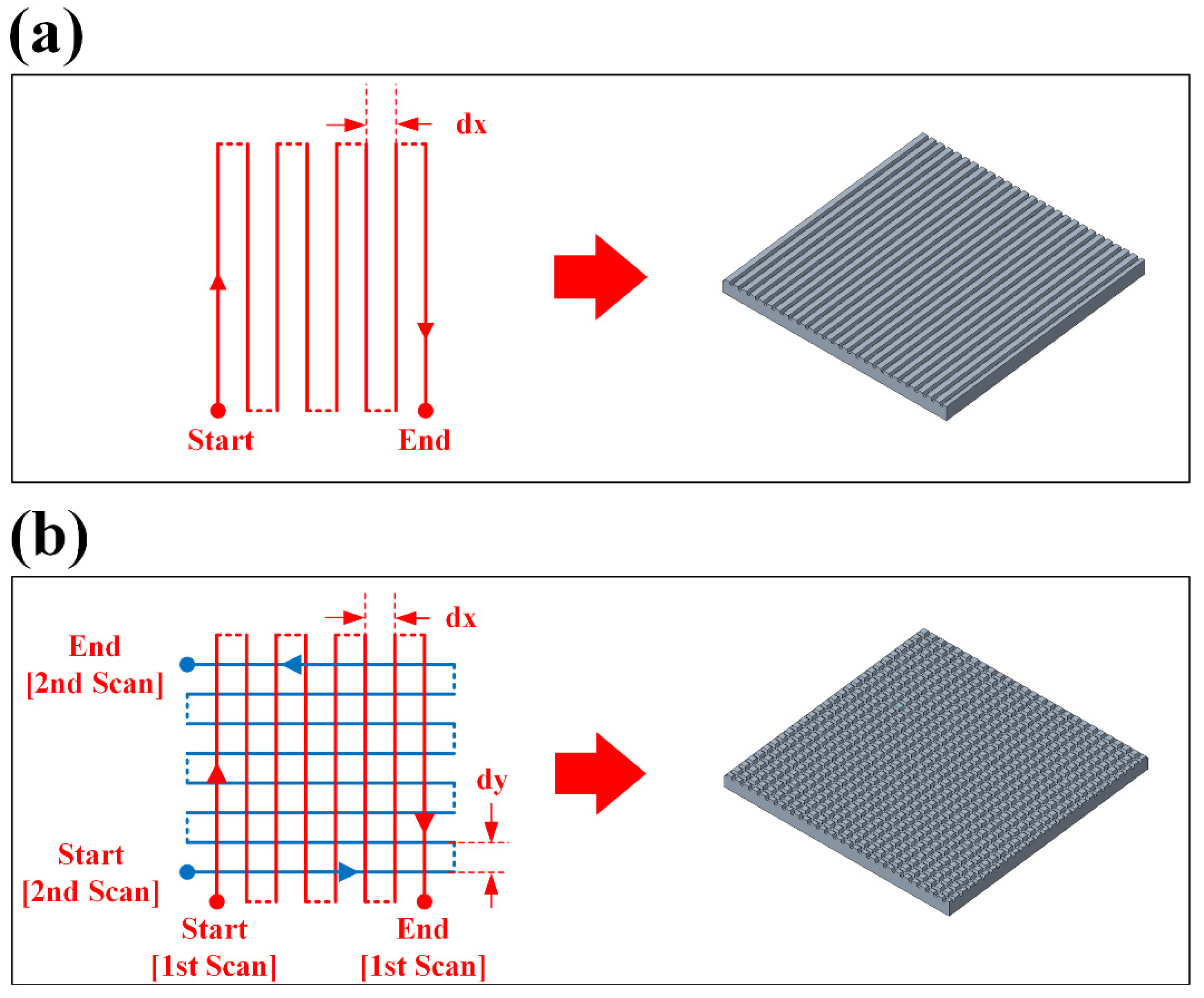
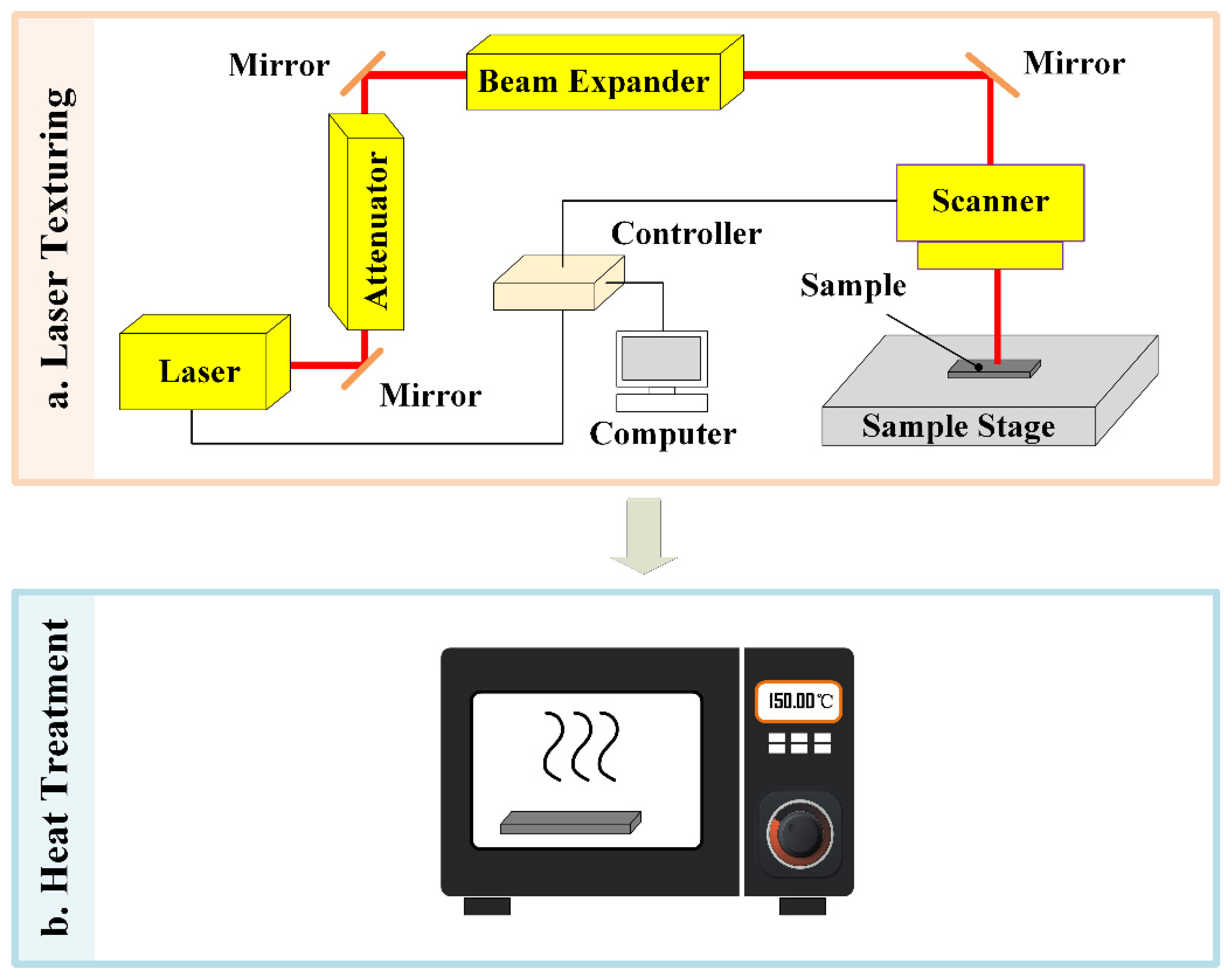
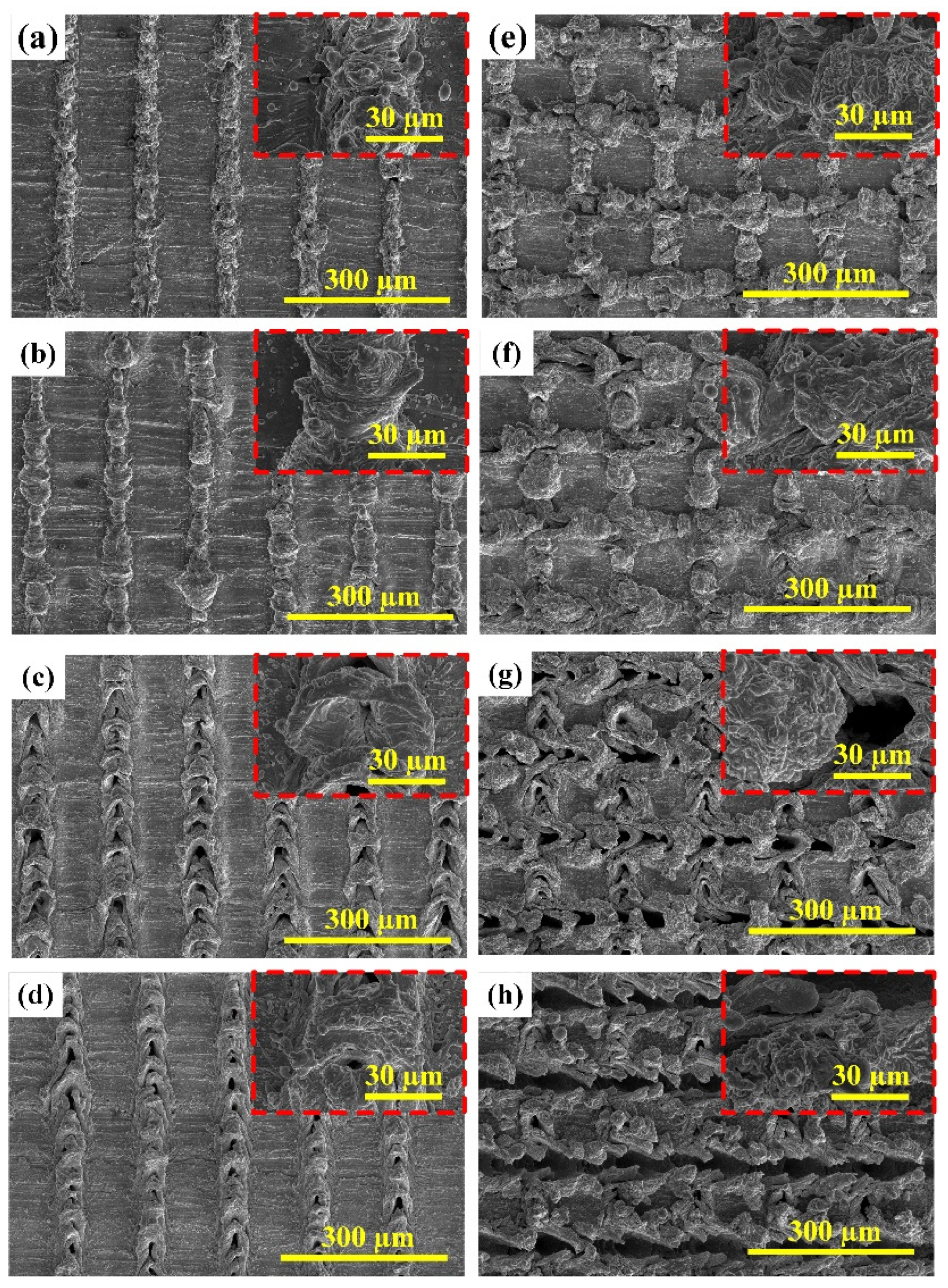
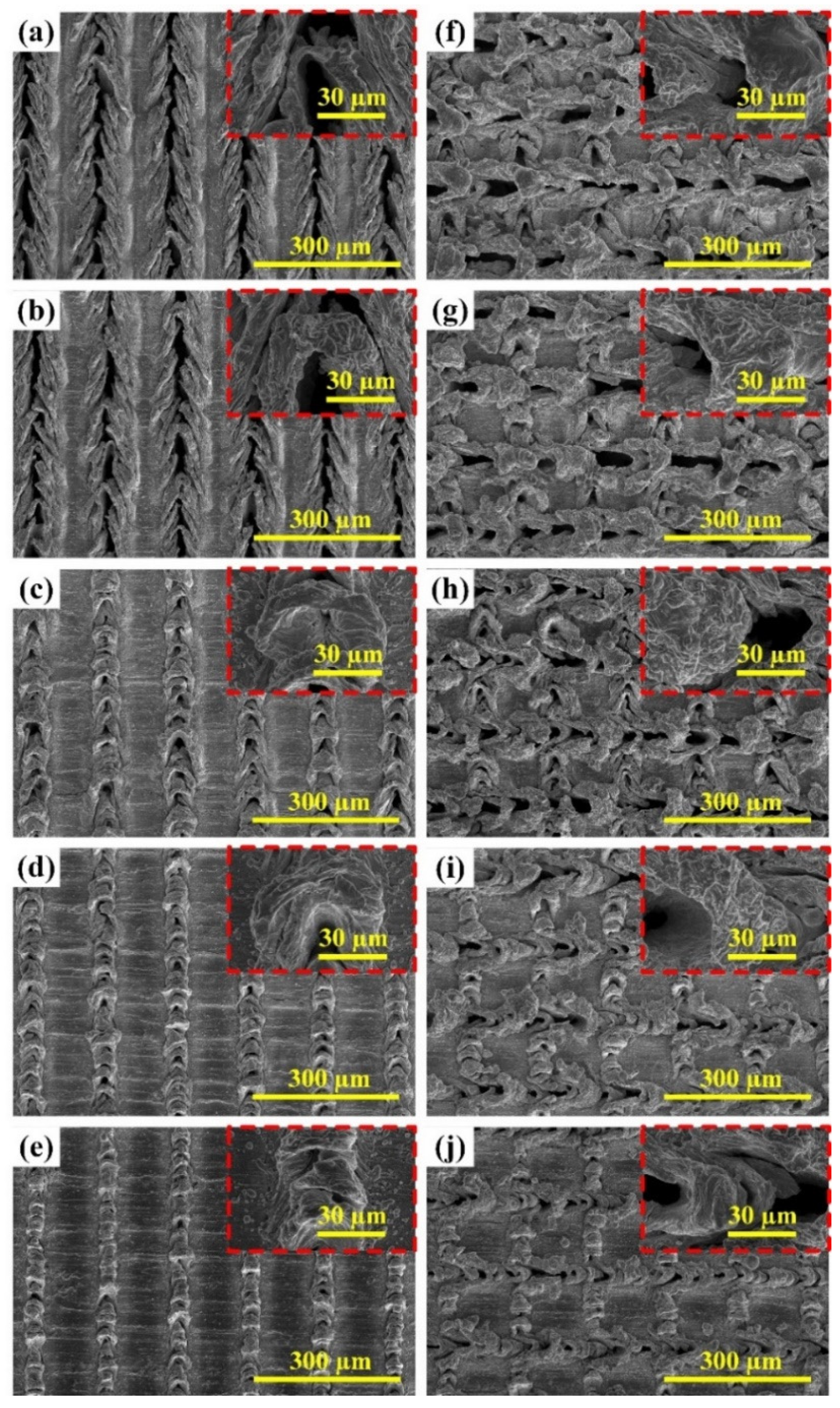
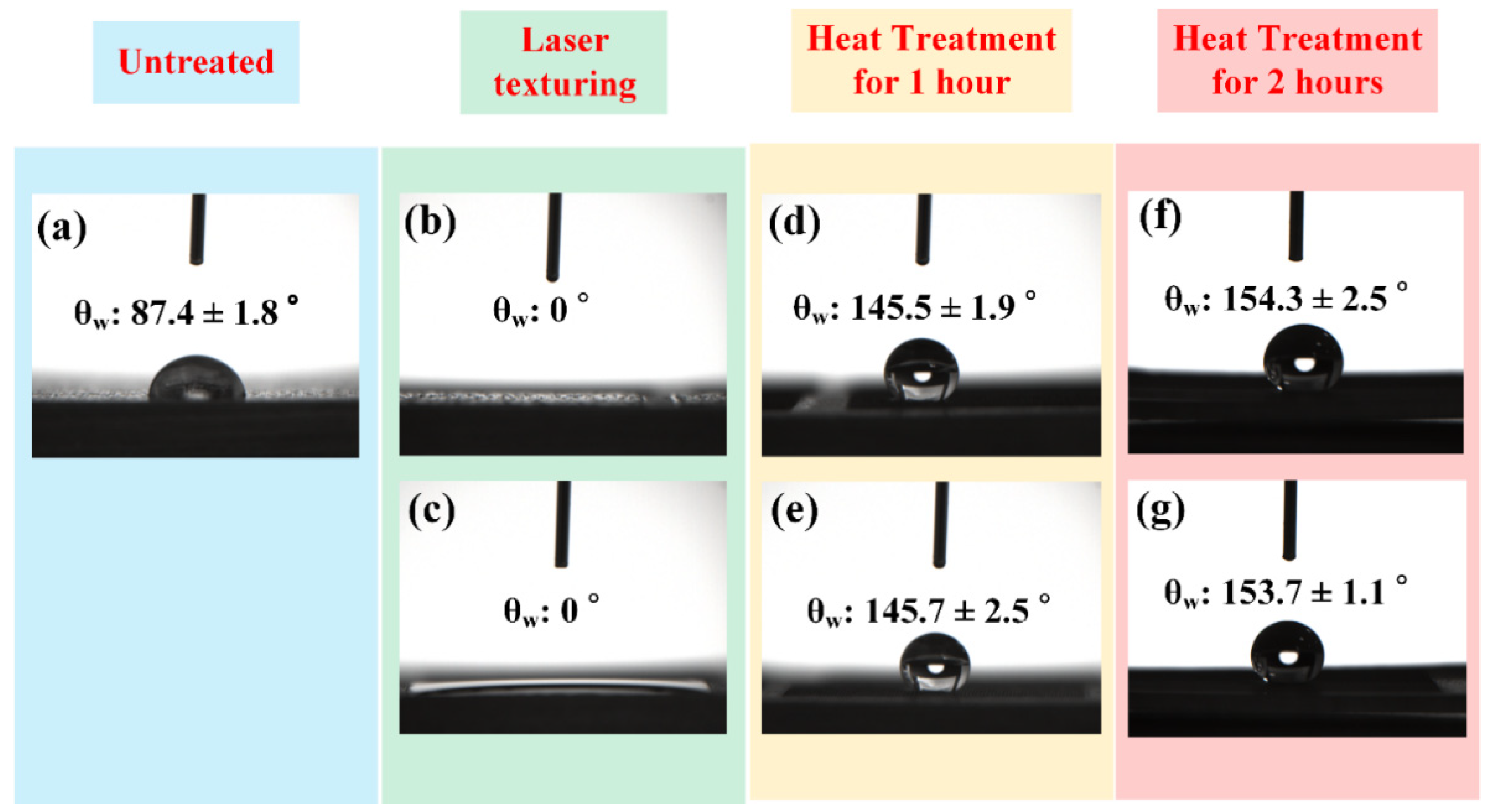
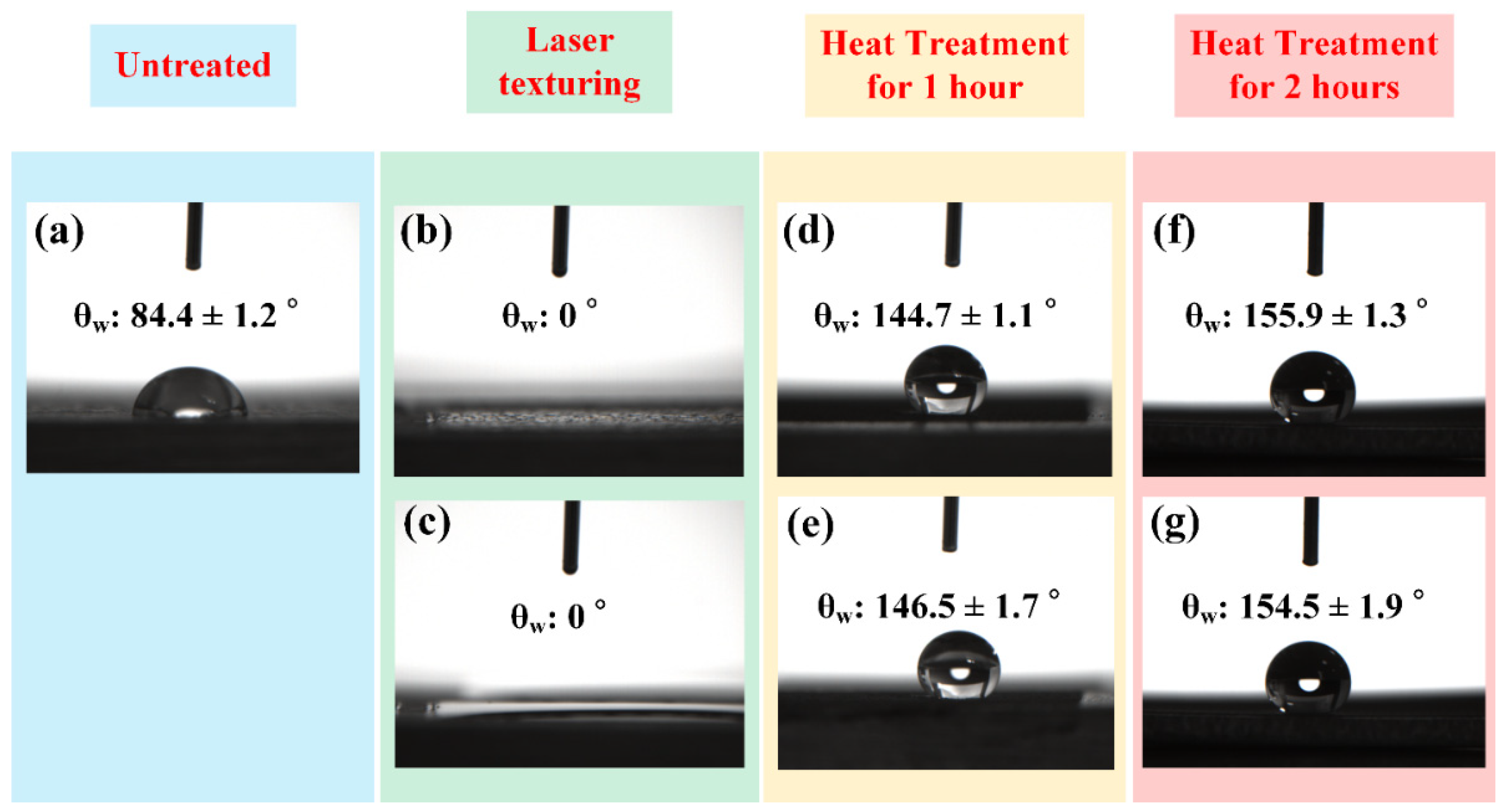
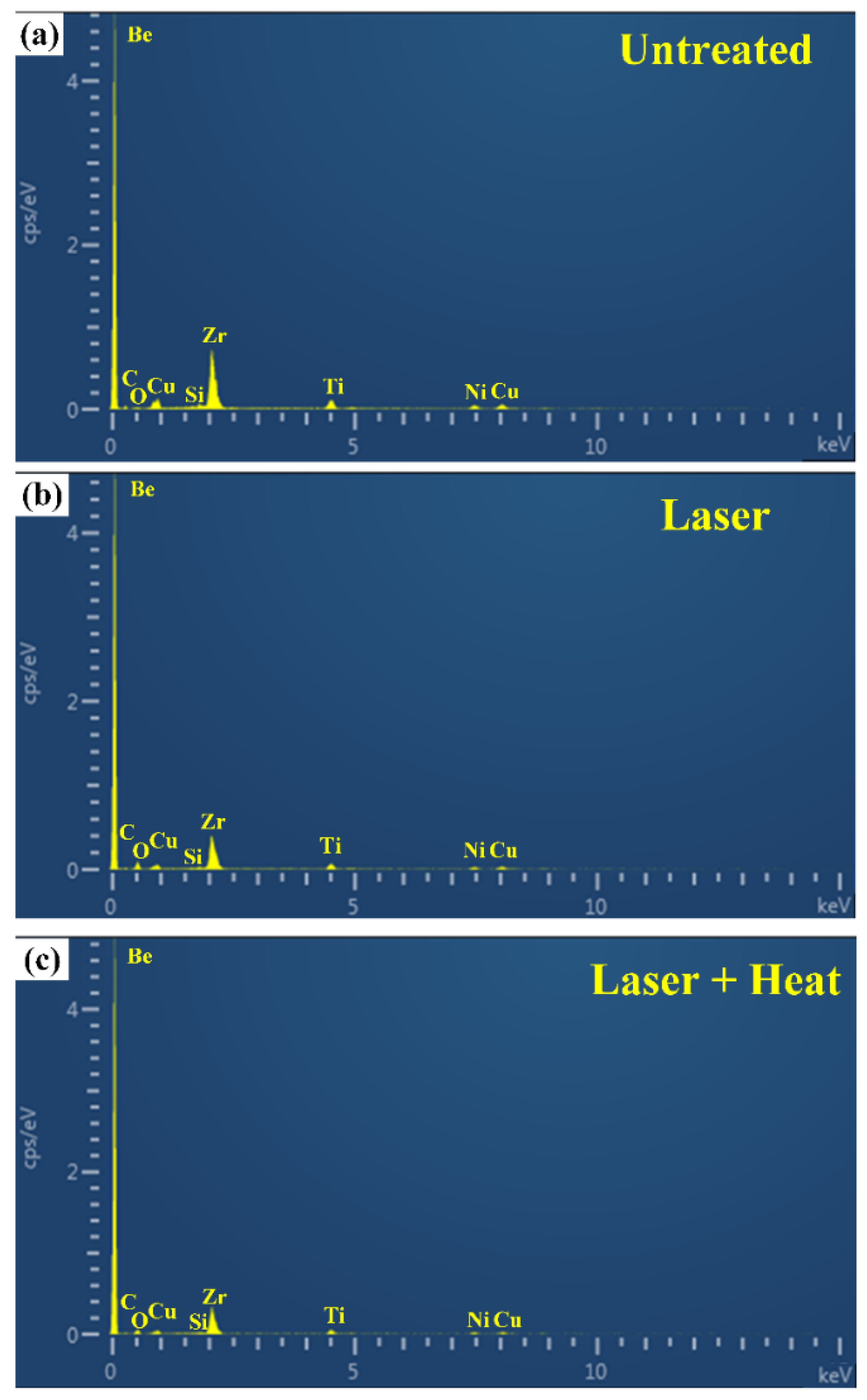
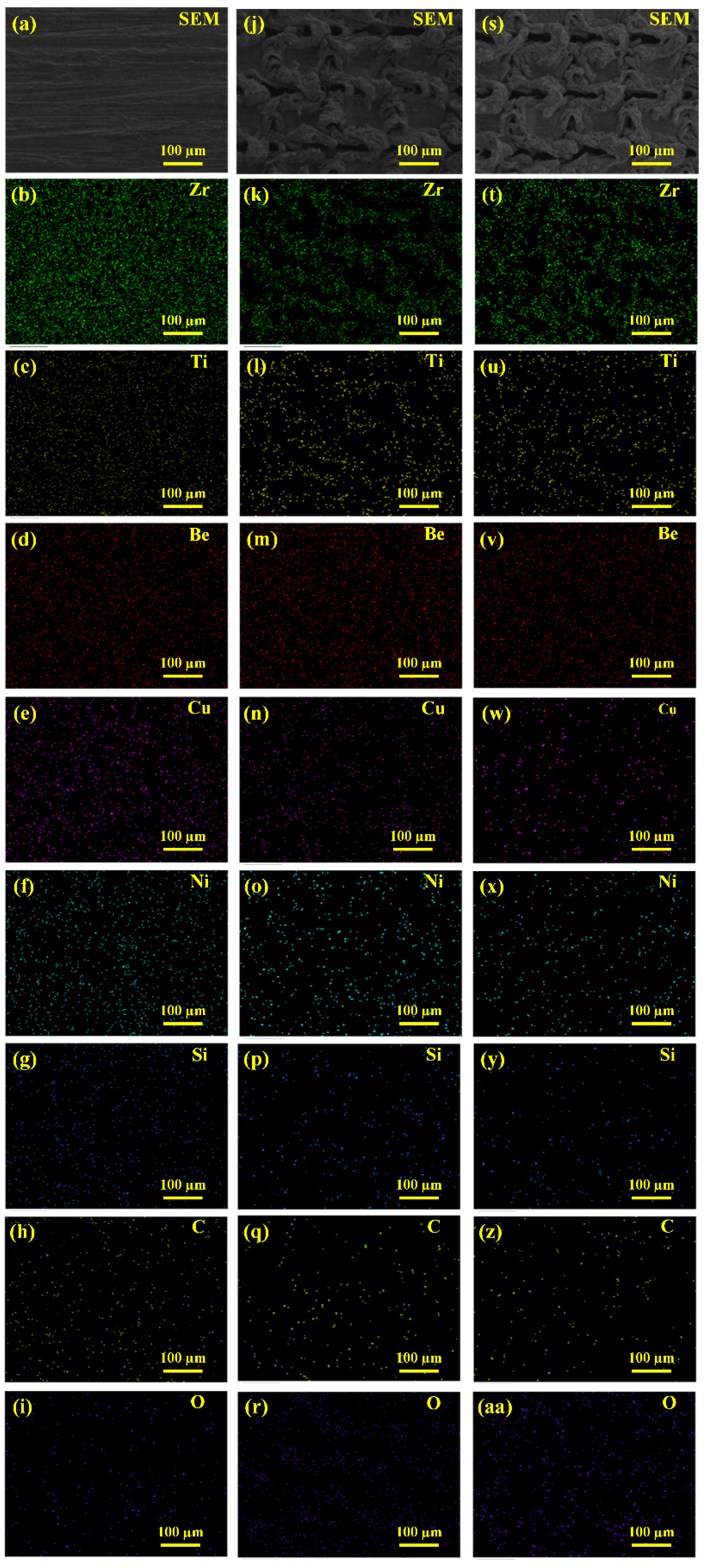
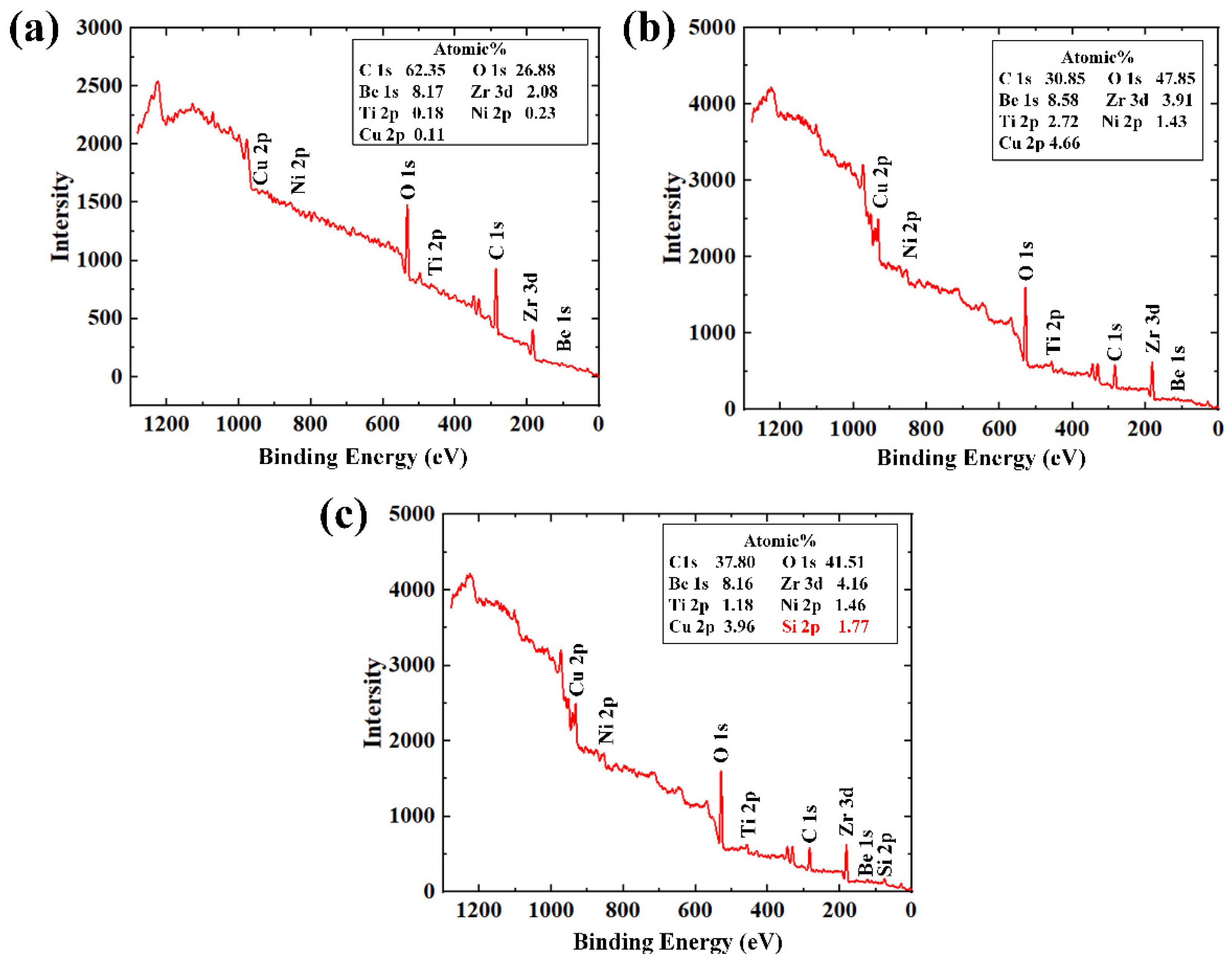
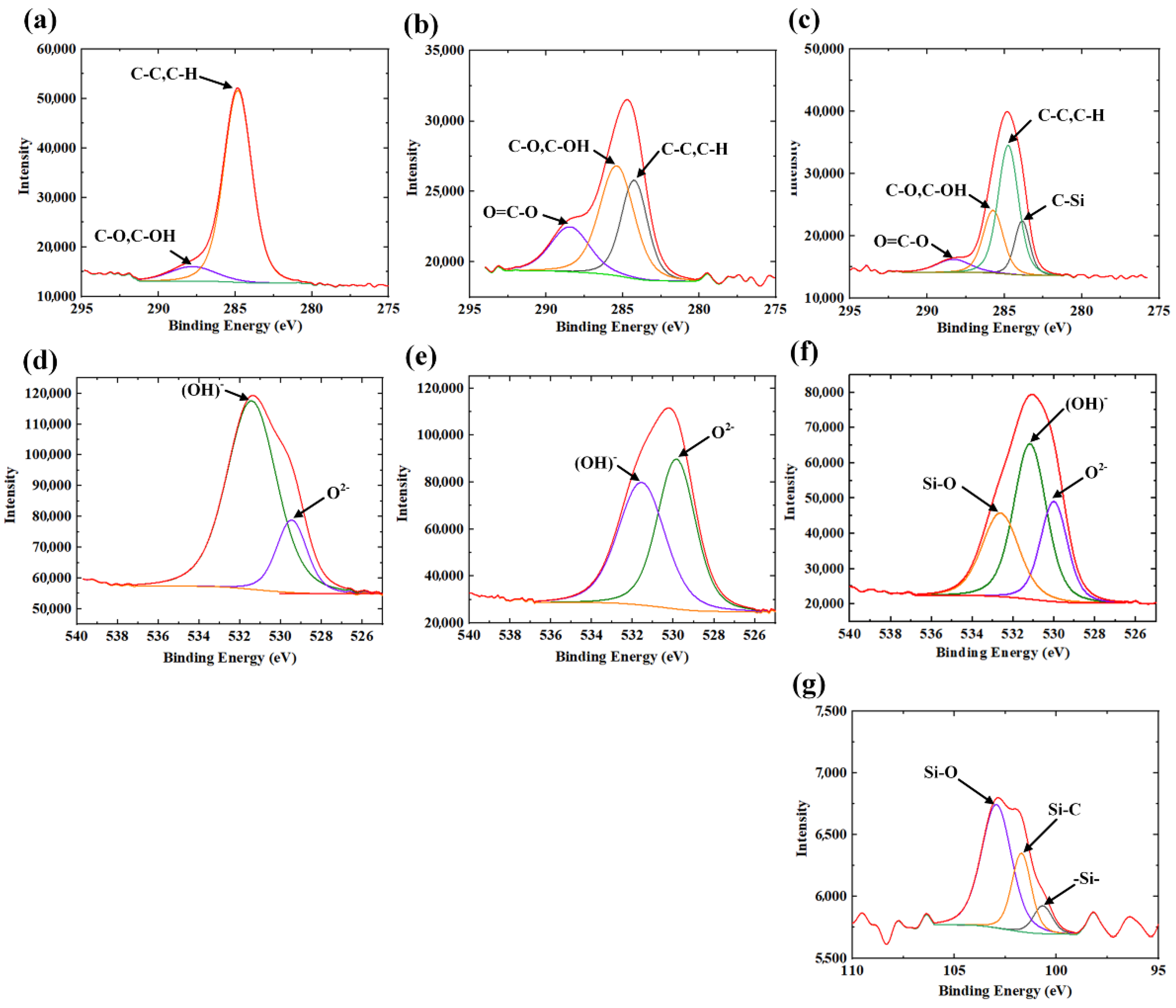
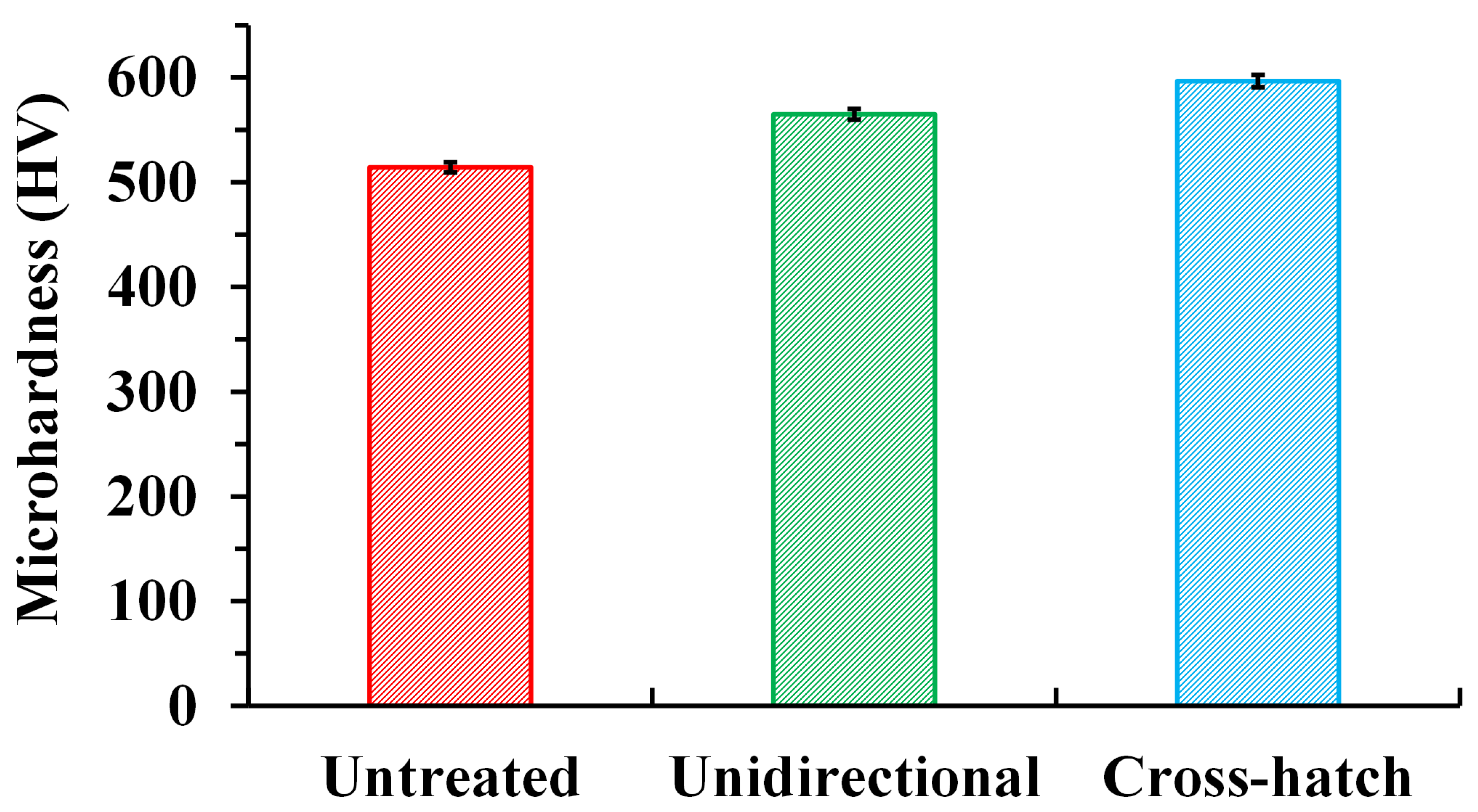
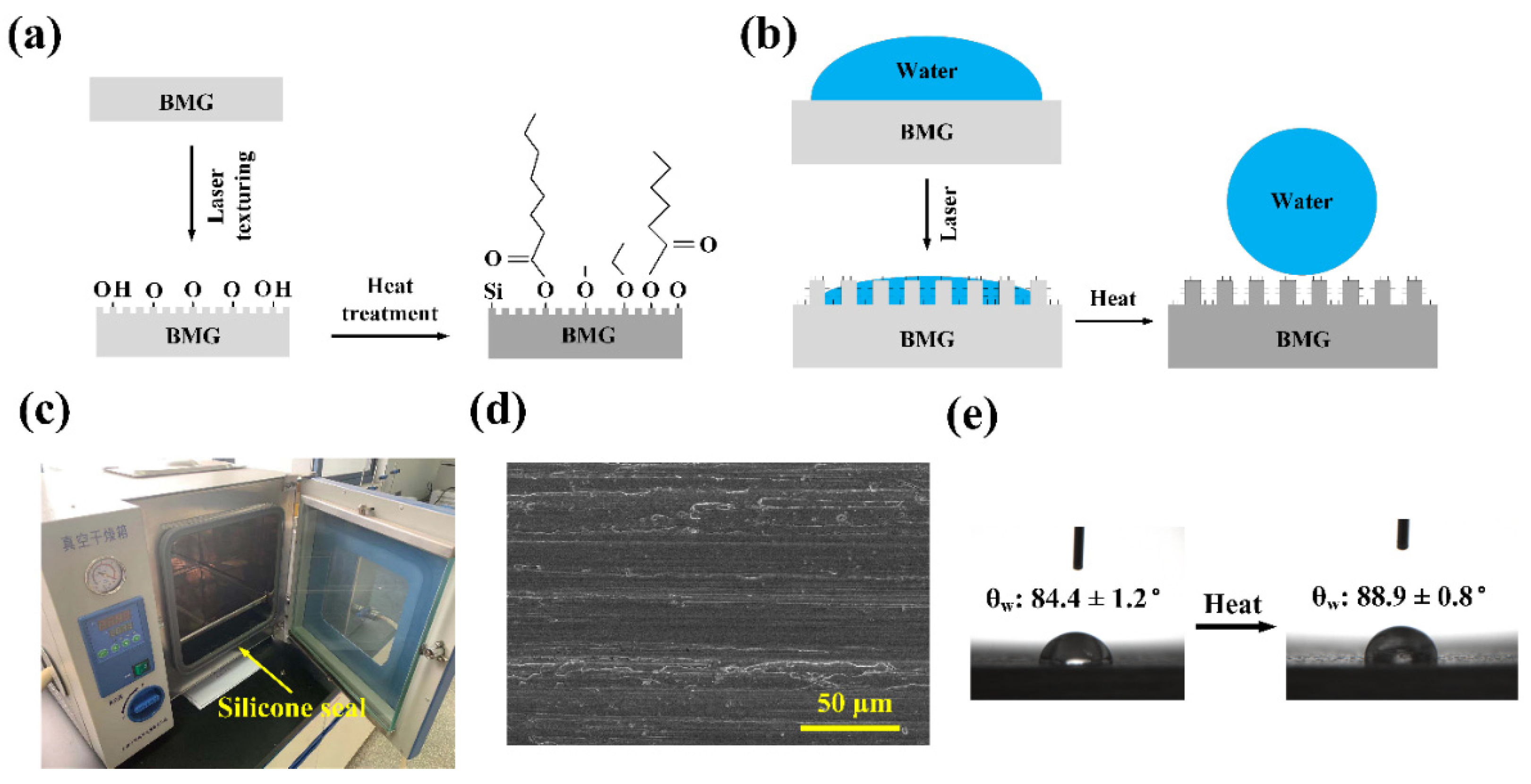
| Name of Parameter | Value |
|---|---|
| Average power (W) | 9.0, 10.5, 12.0, 13.5, 15.0 |
| Repetition rate (kHz) | 30 |
| Pulse width (ns) | 20 |
| Scanning speed (mm/s) | 20, 40, 60, 80 |
| Step size (µm) | 150 |
| Power intensity (GW/cm2) | 1.56~2.60 |
| Pulse energy (mJ) | 0.3~0.5 |
| Heat treatment temperature (°C) | 150 |
| Heat treatment duration (h) | 2 |
Publisher’s Note: MDPI stays neutral with regard to jurisdictional claims in published maps and institutional affiliations. |
© 2021 by the authors. Licensee MDPI, Basel, Switzerland. This article is an open access article distributed under the terms and conditions of the Creative Commons Attribution (CC BY) license (https://creativecommons.org/licenses/by/4.0/).
Share and Cite
Wang, Q.; Cheng, Y.; Zhu, Z.; Xiang, N.; Wang, H. Modulation and Control of Wettability and Hardness of Zr-Based Metallic Glass via Facile Laser Surface Texturing. Micromachines 2021, 12, 1322. https://doi.org/10.3390/mi12111322
Wang Q, Cheng Y, Zhu Z, Xiang N, Wang H. Modulation and Control of Wettability and Hardness of Zr-Based Metallic Glass via Facile Laser Surface Texturing. Micromachines. 2021; 12(11):1322. https://doi.org/10.3390/mi12111322
Chicago/Turabian StyleWang, Qinghua, Yangyang Cheng, Zhixian Zhu, Nan Xiang, and Huixin Wang. 2021. "Modulation and Control of Wettability and Hardness of Zr-Based Metallic Glass via Facile Laser Surface Texturing" Micromachines 12, no. 11: 1322. https://doi.org/10.3390/mi12111322





